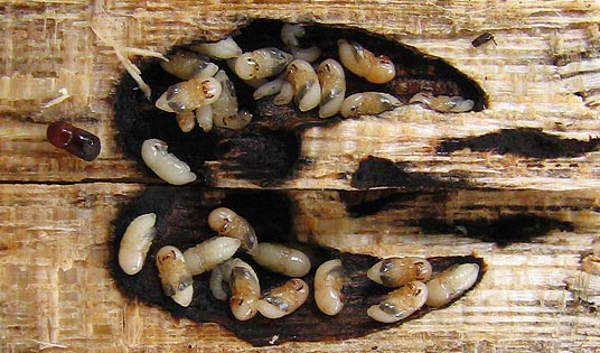 |
|---|
Beetles, wasps and flies could be at the forefront of the next agricultural revolution as scientists draw on insects' millions of years of farming experience in a bid to find new, environmentally friendly ways of cultivating crops.
Dr Peter Biedermann at the Max Planck Institute in Jena, Germany, is convinced that lessons learnt from nature could help improve the sustainability of our agricultural practices. He has been researching the husbandry skills of Ambrosia beetles, which grow their own food source - fungus - and are the only farming insects endemic to Europe.
'Humans may have discovered farming 10 000 years ago,' said Dr Biedermann. 'But Ambrosia beetles have been growing their own food for over 30 million years. Whatever tricks they once evolved are still protecting their crops today.'
In recent years, intensive farming and monocultures have propelled human agriculture to unprecedented gains in productivity. But crop yields are starting to falter. One stress sign is that industrial pesticides tend to lose their edge in a matter of years as bugs and weeds adapt to them.
As farmers resort to higher chemical doses, scientists are investigating more sustainable alternatives. Funded by the EU's Marie Skłodowska-Curie fellowship, Dr Biedermann explores one prospect rooted deeply in agriculture's forgotten past.
Beetles are usually solitary insects, but the Ambrosia kind form well-organised colonies that scoop the rot out of old tree trunks to create fungi incubators within them. Entomologists have long wondered how these creatures learnt to tend crops and fend off pests.
'In some ways, the green fingers of these insects exceed the understanding of modern science,' said Dr Biedermann. 'No one has yet succeeded in farming the fungus in the lab, but it only takes one Ambrosia beetle to make it flower and thrive.'
Invasive moulds
One feat that Dr. Biedermann is starting to understand is the beetle's ability to fend off invasive moulds, which in all logic should abound in the moist environment of their fungus plantations.
By sequencing DNA recovered from beetle nests, he identified strains that match those of bacteria known to produce antibiotics. Preliminary results indicate that these molecules are harmless to the fungus but lethal to invasive moulds that prey on them, which may provide a basis for a new type of pesticide.
 |
|---|
'Ambrosia beetles produce a biological pesticide that adapts to invasive species faster than the invasive species can evolve a resistance to it,' said Dr Biedermann.
Scientists are also trying to harness the parasitic nature of insects to control crop-destroying pests. The EU-funded BUGSIE project is pioneering a biological response to Nezara viridula, a sturdy green stink bug that is pestering farmers worldwide.
Climate change and trade routes have extended the range of this unwelcome traveller from its home in North Africa to fields as far north as France and Germany. Professor Stefano Colazza at the University of Palermo in Italy said that the stink bug's voracious appetite and varied diet have turned it into a global economic burden.
Since stink bugs are highly resistant to pesticides, BUGSIE is researching a sharper weapon - the tiny European wasp named Trissolcus basalis. This natural born killer lays its eggs within those of the stinkbug, eradicating a generation of the pest even before it hatches.
The challenge lies in providing a nurturing environment for the wasps so that they can feed, spread and breed in numbers capable of controlling stink bug populations. By introducing companion plants such as buckwheat that provide nectar for Trissolcus basalis, researchers have boosted stink bug parasitism rates from 38 % to 85 % in field tests in Sicily.
'We have also identified the volatile compounds which guide these wasps towards their food supply,' said Prof. Colazza. By releasing synthetic replicas of the molecules, his team hopes to marshal swarms of Trissolcus basalis to feeding stations spread across large fields and maximise their impact.










Comments
Add a comment